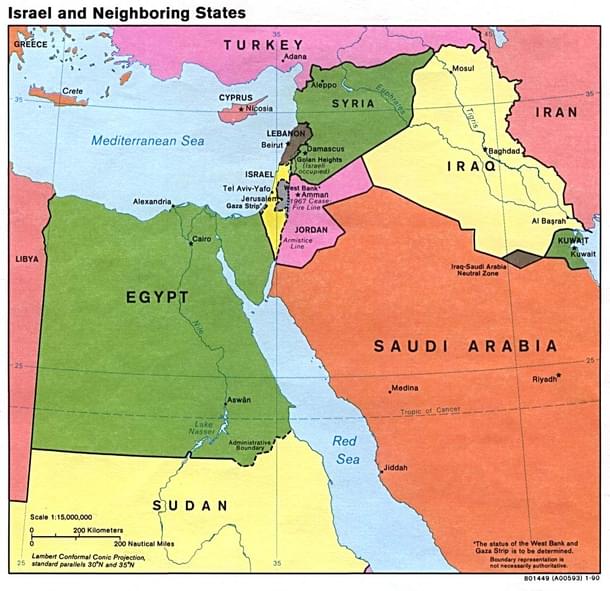News Brief
A Brief History Of Israel As It Battles Violent Escalation With Gaza-Based Terror Groups
Swarajya Staff
May 19, 2021, 02:26 PM | Updated 02:26 PM IST
Save & read from anywhere!
Bookmark stories for easy access on any device or the Swarajya app.


In a three part series, we will explain briefly the history of the formation of Israel, how the tiny nation surrounded by hostile neighbours survived, and the crux of the matter of the Israel-Palestine conflict.
Why Israel is in the news
Israel is currently facing riots between Arabs and Jews within its territory as well as rocket attacks from Islamist terrorists in Gaza.
In response to hundreds of rockets fired by terror group Hamas which controls Gaza, Israel’s Air Force has launched multiple strikes with fighter jets.
Since the fighting began, the Israeli military has launched hundreds of airstrikes, while terrorists in Gaza have fired more than 3,200 rockets into Israel. According to the Gaza Health Ministry, at least 200 Palestinians have been killed in the strikes, including 59 children and 35 women, while Israel has reported 10 dead, including two children, reports The Hindu.
Recent days have seen the most violent escalation in seven years between Israel and terror groups based in Gaza strip, triggered by clashes at Jerusalem’s Al-Aqsa mosque compound. The mosque is built atop of the Temple Mount - the holiest site in Judaism.
How Israel came to be
The story of Israel starts with the emergence of the national movement of the Jewish people known as Zionism in the later half of the nineteenth century, primarily in central and eastern Europe.
The Zionist movement placed the sovereign state for Jews in the ‘promised land’ of Israel, which is considered a God-given inheritance of the Jewish people based on the Torah. This was Palestine in the late 19th century - an area under Ottoman rule with 3,00,000 inhabitants, 20,000 of whom were Jews.

From the early 1880s up to the beginning of the First World War (1914), there were waves of migration of Jews to the land of Israel under the influence of Zionism. By 1914, about 80,000 Jews lived in the area. Religious anti-Jewish hatred was an important contributor to the migration.
The end of World War I marked the end of the Ottoman empire and Palestine becoming a British mandate. It gave impetus to the Zionist demands for Palestine as the Jewish homeland.
The Jews benefited from the British rule, especially since the mandate charter given to Britain by the League of Nations explicitly directed it to facilitate establishment of a Jewish national homeland, as well as Jewish immigration and settlement.
In May 1947, the United Nations (UN) established the UN special committee on Palestine which studied the question of Palestine and the majority recommended partition. The partition was supported by Jews but opposed by the Palestinian Arabs who threatened war.
Interestingly, Soviet Union came out in the support of the partition, and even helped the infant Jewish nation with critical arms supplies in the 1948 war between Israel and Arab states which proved crucial for the latter’s victory.
The Jews at the time were 33 per cent of the population of Palestine and got 55 per cent of the land. The Arabs, who were 66 per cent of the population got 45 per cent of the land. This was because the Western powers believed that the Jewish refugees in Europe would settle in Israel. The expected huge Jewish immigration indeed followed.
The announcement of the partition was followed by a civil war between the Arabs and the Jews. Other Arabs states sent help in the form of the Arab Liberation Army which joined the fight against the Jewish population in Palestine.
The Jews faced an obvious disadvantage. They were lesser in numbers, plus, significant Arab populations fragmented the Jewish parts of Palestine and could control the roads, making it impossible for the dispersed Jewish population to connect. The Jewish population in Jerusalem was completely cut off.
For some time, it seemed like Jews were on the verge of failure. The United States (US), in March 1948, suggested that the partition plan be abandoned.
However, for Jews, this was an existential question. They knew that a defeat could even mean a second holocaust. The statements by the Arab leaders at the time certainly indicated that possibility.
In April 1948, Jews launched an offensive Plan D whose goal was to control all of the territory of the Jewish state - including the Arab towns and villages that were inside it. The Arab population so conquered could remain in place unless they resisted the Jewish occupation.
Plan D was successful in that it allowed the conquest of territory, including ending the siege of Jerusalem. But the fight also saw extreme violence from both the sides. The Arab media at the time greatly popularised (and even exaggerated) the reports of the massacre of Arabs by Jews in order to pressurise their governments to attack. The net result was Palestinians leaving the territory, hence the Palestinian refugee problem.
Success of Plan D also enabled the Jews to prepare effectively for the expected invasion of the neighbouring Arab states. On 14 May 1948, the British mandate came to an end and Israel declared independence.
Initially, the neighbouring Arab states were reluctant to attack Israel and were hoping that the threat of invasion itself would be enough to pressurise the international community to retract the partition plan.
After the Israeli declaration of independence, they did invade, but were poorly prepared. They had to leave a chunk of their forces at home to safeguard their own regimes. The coordination was poor and each country also had its own agenda. Iraq had eyes on the Haifa port; the Jordanians were constrained by the British; and Egypt didn’t want the former two to gain influence in Palestine.
Nevertheless, it was 40 million Arabs in surrounding countries versus 6,50,000 Jews in Palestine. The Arabs also had an advantage in military equipment and air power.
However, the Israelis had a ‘do or die’ approach. They quickly mobilised the equipment as well as soldiers. They prioritised strategic gains over the religious and the symbolic. In fact, by the end of the war, the Israelis outnumbered the Arabs in men and material. They were also in a position to capture Jerusalem in totality, but chose not to, instead leaving half to the Jordanians.
The UN resolution stated that Jerusalem would be given neither to Israelis nor Palestinians, and instead will be internationalized. The Israelis thought that if they took the whole city, they would end up with nothing; but if each side controlled half of the city, the city would just be divided between the two.
Israelis had won the 1948 war against all odds.
In December 1948, the UN passed a resolution stating that the refugees wishing to return to their homes and live at peace with their neighbors should be permitted to do so at the earliest practicable date, and that compensation should be paid for the property of those choosing not to return by the governments or authorities responsible.
Clearly, the resolution didn’t grant the Palestinian refugees an unconditional right to return. and therefore, the Arab states who were UN members voted against it. The refugee issue continues to be a hurdle in the resolution of the Israel-Palestine conflict.
This is the story of Israel’s formation. In the next part, we shall look at how Israel survived amidst hostile neighbours and further developments in the Israel-Palestine conflict.





